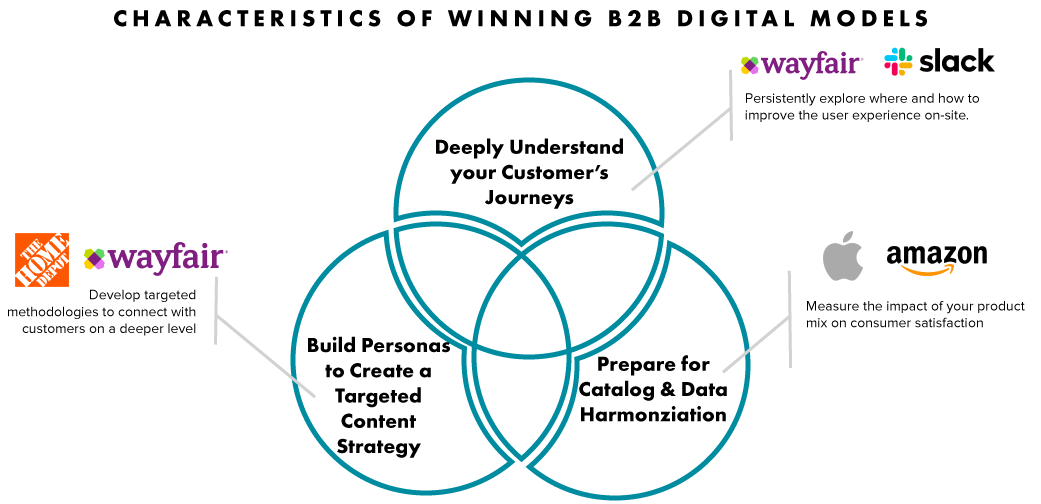Building Your B2B Digital Marketing Strategy
Companies looking to continuously stay ahead of the digital curve need to purposefully and systematically create digital experiences rooted in a deep understanding of their customer needs. This is especially true in the B2B space, where historically, user requirements were wrongfully used as proxies for developing the right user experiences. We’re walking through key considerations when building your company’s B2B digital marketing strategy.
Over the past several years we have witnessed a shift across B2B organizations to focus resources and efforts towards reimagining and redesigning their digital experiences in ways that align more closely to B2C operating models. By investing in digital enablement, B2B organizations can create ‘stickiness’ with customers while also driving further differentiation from competitors.
This increasing interest – and need – to develop B2C digital capabilities in a B2B world is forcing organizations to adapt their evolving list of digital best practices to stay competitive in their industry. As we look across work we’ve done for clients over the past year, we share three key characteristics that embody what enables B2B organizations to succeed in a digital world:
1. Deeply Understand Your Customer’s Digital Journeys
Digital transformation can be a very costly investment, so it’s no wonder that B2B companies often struggle with outdated eCommerce systems and processes. However, with increasing competition, B2B companies can’t only rely on their product or keeping their current customers to stay afloat. Customer experience cannot be an afterthought –companies need to put their customer at the center point of any decision they make. However, good ideas don’t come from what companies think the customer wants – they need to be backed by research and customer data. Core capabilities such as consumer insights via surveys, website analytics, or 3rd party customer data providers are the foundation of making informed hypotheses about a consumer base. Every consumer is unique, and properly identifying the right data to collect and analyze will enable companies to enhance the overall consumer journey in an efficient way.
A successful company will start thinking about the end user early and embrace customer perception as reality. For instance, Wayfair prioritizes obtaining a holistic and thorough understanding of each customer’s journey, from the moment they land on site to when they leave. They implement this B2B digital marketing strategy by employing specialists to focus on every product category available, where the specialist is constantly gathering data to informatively modify and transform each customer’s experience into a best-in-class journey. By concentrating on specific consumer product needs (i.e. a need for a new sink or a need for a new bed) and continuously evaluating those specific on-site interactions, Wayfair is proactively centering their decision-making on understanding why customers are engaging the way they are rather than just understanding what they are doing.
Another simple way to obtain meaningful consumer insights is to directly ask for feedback on the various evolutions of a product or service. With a focus on shaping how companies and teams communicate, Slack exemplifies the value of this approach to insights by acquiring honest, immediate ideas from their customers on how to fine-tune their platform for each of the consumers’ needs. Slack truly wants to connect with their audience to provide them with the best experience possible, and they’ve done exactly that by building trust and forming relationships with their consumers.
Digital customer centricity is easier said than done, which is why it is important to generate an approach that is tailored to a specific target audience.
2. Build Personas to Create a Targeted Content Strategy
There are many ways for companies to connect with customers, whether it be via social media, in person, or online, and identifying the most relatable method can be a challenge. The difficulty lies in understanding the various motivations, desires, and needs of consumers. One approach to address this is for B2B companies to create a representative number of user personas which encapsulate the major consumer preferences and purchase behaviors. This enables companies to educate and interact with their consumers in an advantageous way prior to consumers making a purchase decision.
Marketing techniques vary based on the type of consumer and the products or services offered, and B2B companies can utilize a mix of these tools to attract and connect with their consumers on a deeper level. B2B companies already have an advantage when addressing their target consumer base because the audience usually has a common goal in mind: to find the best product or service for their needs in a specific field or industry. To get ahead of the competition, it’s important to effectively communicate your value proposition through a variety of content.
Home Depot excels in this area by providing not only the base product information for customers to compare, but also Project Calculators, How-to Guides, and Online Workshops for consumers to utilize to inform their decision-making. However, one consideration for digital leaders is to understand the similarities and/or differences in their B2B vs. B2C customers (if/as applicable). For example, Home Depot’s B2C and B2B customer bases are very similar, with the key differentiator being the size of the project(s) the customer is completing. Not all companies can successfully feature the same content to both B2C and B2B customers while satisfying both of their end user needs.
For instance, there is a separate division of Wayfair for B2B consumers, Wayfair Professional, which customizes the onsite user experience based on their self-identified industry focus. Wayfair Professional develops specific content for their site to relate to their consumer base rather than utilizing B2C materials, which may or may not be relevant for B2B customers. This distinction establishes Wayfair Professional as a key player in the B2B world and attracts B2B customers from a diverse set of industries. There are many benefits to providing consumers with personalized resources, but there’s only so much a company can do if there lacks a well-maintained product portfolio.
3. Prepare for Catalog and Data Harmonization
An area often overlooked when analyzing consumer insights for a B2B digital marketing strategy is the bigger picture of how a company’s catalog fulfills end-user requirements. While there are many formulas to enable success in this regard, the common success factor is the ability to satisfy customer demands with what is available and easily findable.
Amazon may have everything a person would need to survive, but finding those items is a challenge in and of itself. Search algorithms are constantly changing, and since the algorithms factor in considerations such as keywords, prior clicks, and hidden filters, the most relevant products are not always shown to customers due to the infinite number of products available. While it can be a frustrating customer experience to spend a lot of time searching for the right product, Amazon understands that their consumers typically arrive with a specific product in mind; thus, the longer navigation time would not have a significant negative impact on Amazon’s overall business because customers are not frequently searching the entire site.
A separate approach to ensure your company stays on top of everchanging trends while still providing a high-quality customer experience is to constantly innovate your product or service offerings. It’s common knowledge that Apple has a few core products, such as the iPhone, MacBook, and Apple Watch. What is often forgotten, aside from the month of September, is how Apple continuously evolves their core product functionalities while simultaneously adding new product lines, such as AirPods and Apple TV, to expand their catalog breadth. It isn’t that Apple has a wide category offering like Amazon, but the particular items available allow for a more streamlined navigation throughout the site.
B2B companies can prevent losing business due to these pitfalls by optimizing both their supply chain and onsite navigation. When determining any changes, it’s important to keep in mind that customers are becoming more and more accustomed to the immediate purchase gratification that comes from 2-day delivery and same-day pick up. This puts an added pressure on small- to medium-sized businesses competing with major players like Apple and Amazon, showing why it’s even more crucial for those companies to build relationships with their customers and provide them with a seamless purchase experience.
Moving Your B2B Digital Marketing Strategy Forward
In the past, the digital characteristics mentioned above might have been equated more with B2C organizations more than B2B companies. Successful companies looking to stay at the forefront of future digital evolution need to adapt to a multitude of industry trends and utilize their resources to not only understand their evolving consumers’ needs, but to educate and engage with them throughout their consumer journey.
Subscribe to Clarkston's Insights
Contributions by Danielle Cataldo.




